
The radial engine is a reciprocating type internal combustion engine configuration in which the cylinders "radiate" outward from a central crankcase like the spokes of a wheel. It resembles a stylized star when viewed from the front, and is called a "star engine" in some other languages.

An aircraft engine, often referred to as an aero engine, is the power component of an aircraft propulsion system. Aircraft using power components are referred to as powered flight. Most aircraft engines are either piston engines or gas turbines, although a few have been rocket powered and in recent years many small UAVs have used electric motors.

The BMW 801 was a powerful German 41.8-litre (2,550 cu in) air-cooled 14-cylinder-radial aircraft engine built by BMW and used in a number of German Luftwaffe aircraft of World War II. Production versions of the twin-row engine generated between 1,560 and 2,000 PS. It was the most produced radial engine of Germany in World War II with more than 61,000 built.
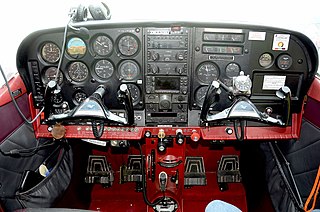
Aircraft engine controls provide a means for the pilot to control and monitor the operation of the aircraft's powerplant. This article describes controls used with a basic internal-combustion engine driving a propeller. Some optional or more advanced configurations are described at the end of the article. Jet turbine engines use different operating principles and have their own sets of controls and sensors.

In aeronautics, a ducted fan is a thrust-generating mechanical fan or propeller mounted within a cylindrical duct or shroud. Other terms include ducted propeller or shrouded propeller. When used in vertical takeoff and landing (VTOL) applications it is also known as a shrouded rotor.
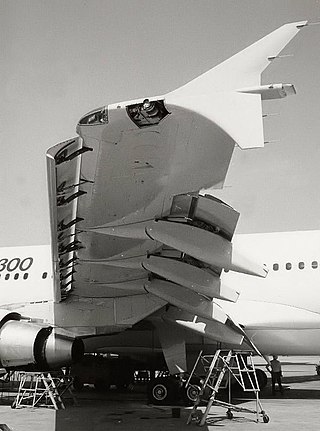
A flap is a high-lift device used to reduce the stalling speed of an aircraft wing at a given weight. Flaps are usually mounted on the wing trailing edges of a fixed-wing aircraft. Flaps are used to reduce the take-off distance and the landing distance. Flaps also cause an increase in drag so they are retracted when not needed.
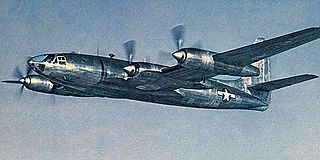
The Republic XF-12 Rainbow was an American four-engine, all-metal prototype reconnaissance aircraft designed by the Republic Aviation Company in the late 1940s. Like most large aircraft of the era, it used radial engines, specifically the Pratt & Whitney R-4360 Wasp Major. The XF-12 was referred to as "flying on all fours" meaning: four engines, 400 mph (640 km/h) cruise, 4,000 mi (6,400 km) range, at 40,000 ft (12,000 m). The aircraft was designed to maximize aerodynamic efficiency. Although innovative, the jet engine and the end of World War 2 made it obsolete, and it did not enter production. A proposed airliner variant, the RC-2, was deemed uneconomical and cancelled before being built.
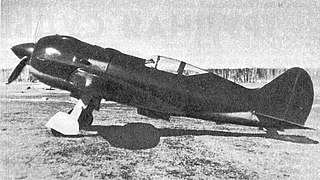
The Polikarpov I-185 was a Soviet fighter aircraft designed in 1940. It was flown with three engines but all of them were either insufficiently developed for service use or their full production was reserved for other fighters already in production. The I-185 program was cancelled on 27 January 1943.
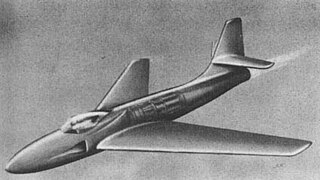
A NACA duct, also sometimes called a NACA scoop or NACA inlet, is a common form of low-drag air inlet design, originally developed by the U.S. National Advisory Committee for Aeronautics (NACA), the precursor to NASA, in 1945.

The Curtiss XP-42 was an experimental fighter built by Curtiss Aircraft in the late 1930s to research engine cooling and improving the performance of the Curtiss P-36.

A cowling is the removable covering of a vehicle's engine, most often found on automobiles, motorcycles, airplanes, and on outboard boat motors. On airplanes, cowlings are used to reduce drag and to cool the engine. On boats, cowlings are a cover for an outboard motor. In addition to protecting the engine, outboard motor cowlings need to admit air while keeping water out of the air intake.

In aeronautics, an aircraft propeller, also called an airscrew, converts rotary motion from an engine or other power source into a swirling slipstream which pushes the propeller forwards or backwards. It comprises a rotating power-driven hub, to which are attached several radial airfoil-section blades such that the whole assembly rotates about a longitudinal axis. The blade pitch may be fixed, manually variable to a few set positions, or of the automatically variable "constant-speed" type.
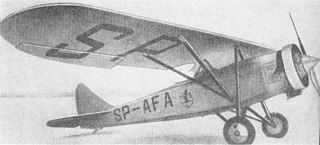
A Townend ring is a narrow-chord cowling ring fitted around the cylinders of an aircraft radial engine to reduce drag and improve cooling.
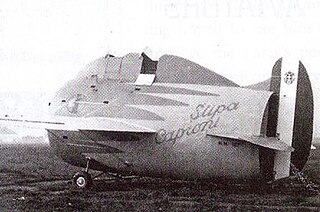
The Stipa-Caproni, also known as the Caproni Stipa, was an experimental Italian aircraft designed in 1932 by Luigi Stipa (1900–1992) and built by Caproni. It featured a hollow, barrel-shaped fuselage with the engine and propeller completely enclosed by the fuselage—in essence, the whole fuselage was a single ducted fan. Although the Regia Aeronautica was not interested in pursuing development of the Stipa-Caproni, its design influenced the development of jet propulsion.
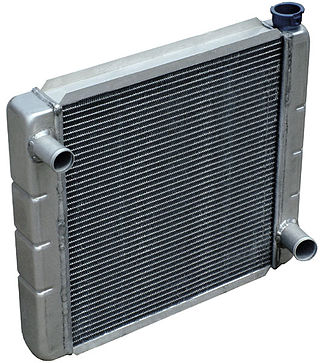
Radiators are heat exchangers used for cooling internal combustion engines, mainly in automobiles but also in piston-engined aircraft, railway locomotives, motorcycles, stationary generating plant or any similar use of such an engine.
The Bristol Type 92, sometimes known as the Laboratory biplane, was an aircraft built by the Bristol Aeroplane Company to address the differences between wind tunnel cowling models and full scale cowling for radial engines and was designed as a scaled-up version of a wind tunnel model aircraft. One was built and flew in the mid-1920s.

The Meredith effect is a phenomenon whereby the aerodynamic drag produced by a cooling radiator may be offset by careful design of the cooling duct such that useful thrust is produced by the expansion of the hot air in the duct. The effect was discovered in the 1930s and became more important as the speeds of piston-engined aircraft increased over the next decade.
The Wright R-4090 Cyclone 22 was an American experimental radial piston engine designed and built in prototype form by Wright Aeronautical during the 1940s.
A rotor wing is a lifting rotor or wing which spins to provide aerodynamic lift. In general, a rotor may spin about an axis which is aligned substantially either vertically or side-to-side (spanwise). All three classes have been studied for use as lifting rotors and several variations have been flown on full-size aircraft, although only the vertical-axis rotary wing has become widespread on rotorcraft such as the helicopter.

The Propeller Research Tunnel (PRT) was the first full-scale wind tunnel at the National Advisory Committee for Aeronautics (NACA) Langley Research Center, and the third at the facility. It was in use between 1927 and 1950 and was instrumental in the drag reduction research of early American aeronautics. In 1929, NACA was awarded its first Collier Trophy for the NACA cowling which was tested and developed using the Propeller Research Tunnel.


















